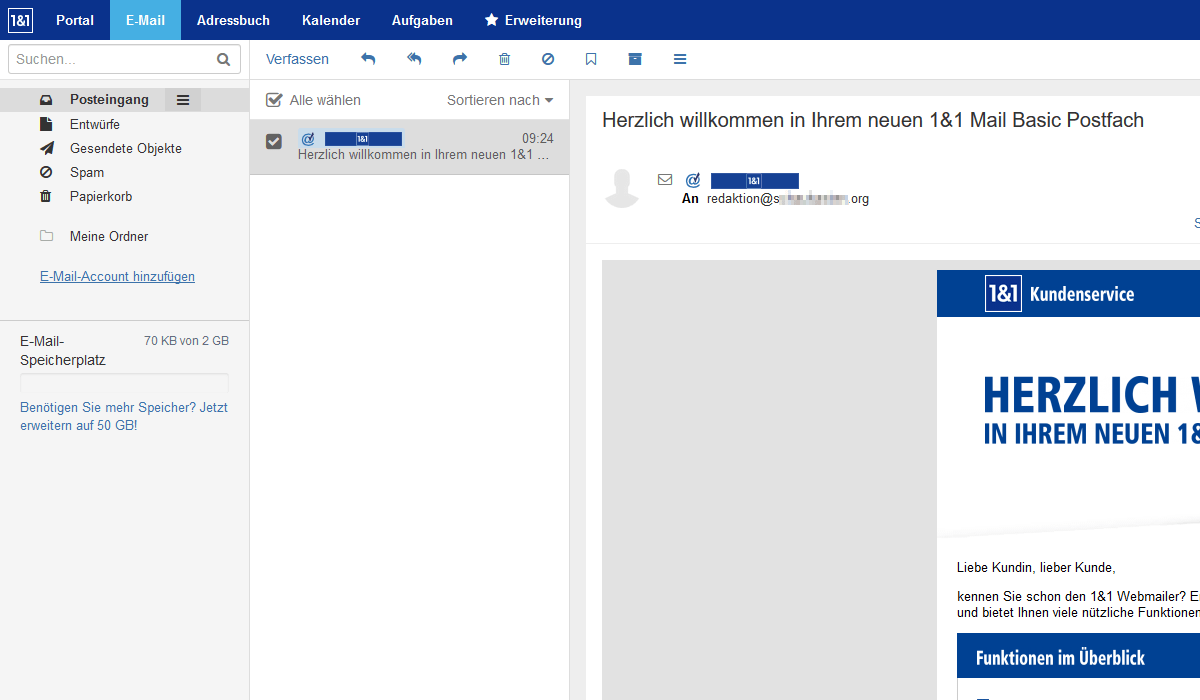

- Webmailer 1und1 deutsch software#
- Webmailer 1und1 deutsch code#
- Webmailer 1und1 deutsch free#
- Webmailer 1und1 deutsch windows#
Several vendors produce tools to provide a MAPI interface to webmail.
Webmailer 1und1 deutsch windows#
Microsoft Windows applications by default create email messages via MAPI. This usually means a greater reliance on tables and inline stylesheets. Due to the varying treatment of HTML tags, such as and, as well as CSS rendering inconsistencies, email marketing companies rely on older web development techniques to send cross-platform mail. There are significant differences in rendering capabilities for many popular webmail services such as Gmail, and Yahoo! Mail. The use of both a webmail client and a desktop client using the IMAP4 protocol allows the contents of the mailbox to be consistently displayed in both the webmail and desktop clients and any action the user performs on messages in one interface will be reflected when the email is accessed via the other interface. However, one may choose to leave the emails on the server, in which case this problem does not occur. The user is limited to previewing messages using the web client before they are downloaded by the desktop email client. For example, email messages that are downloaded by the desktop client and are removed from the server will no longer be available on the webmail client.
Webmailer 1und1 deutsch software#
The market for webmail application software has continued into the 2010s.Įmail users may find the use of both a webmail client and a desktop client using the POP3 protocol presents some difficulties. In some cases, webmail application software is developed in-house by the organizations running and managing the application, and in some cases it is obtained from software companies that develop and sell such applications, usually as part of an integrated mail server package (an early example being Netscape Messaging Server ).
Webmailer 1und1 deutsch free#
Webmailer 1und1 deutsch code#
Burt Rosenberg at the University of Miami, released his "Webex" application source code in a post to on August 8, 1995, although it had been in use as the primary email application at the School of Architecture where Mankins worked for some months prior.īill Fitler's webmail implementation was further developed as a commercial product, which Lotus announced and released in the fall of 1995 as cc:Mail for the World Wide Web 1.0 thereby providing an alternative means of accessing a cc:Mail message store (the usual means being a cc:Mail desktop application that operated either via dialup or within the confines of a local area network). Matt Mankins, under the supervision of Dr. In the United States, Matt Mankins wrote "Webex", and Bill Fitler, while at Lotus cc:Mail, began working on an implementation which he demonstrated publicly at Lotusphere on January 24, 1995. Remy Wetzels' "WebMail" was written while he was studying at the Eindhoven University of Technology in the Netherlands for the DSE and was released early January 1995. In Europe, there were three implementations, Søren Vejrum's " Luca Manunza's "WebMail" was written while he was working at CRS4 in Sardinia, from an idea of Gianluigi Zanetti, with the first source release on March 30, 1995. In the next two years, however, several people produced working webmail applications.


The first Web Mail implementation was developed at CERN in 1993 by Phillip Hallam-Baker as a test of the HTTP protocol stack, but was not developed further.


 0 kommentar(er)
0 kommentar(er)
